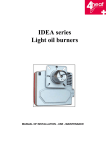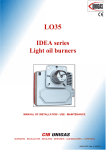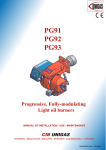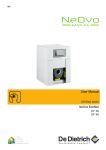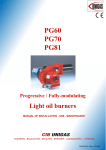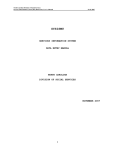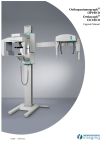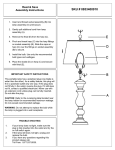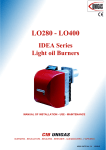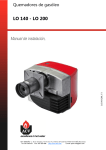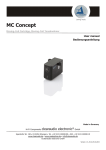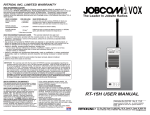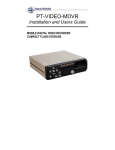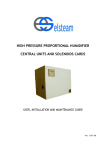Download LO140 LO200 Light oil burners
Transcript
LO140 LO200 Light oil burners MANUAL OF INSTALLATION, USE AND MAINTENANCE BURNERS - BRUCIATORI - BRULERS - BRENNER - QUEMADORES - ГОРЕЛКИ M039154CE Rel. 4.0 09/2011 WARNINGS THIS MANUAL IS SUPPLIED AS AN INTEGRAL AND ESSENTIAL PART OF THE PRODUCT AND MUST BE DELIVERED TO THE USER. INFORMATION INCLUDED IN THIS SECTION ARE DEDICATED BOTH TO THE USER AND TO PERSONNEL FOLLOWING PRODUCT INSTALLATION AND MAINTENANCE. THE USER WILL FIND FURTHER INFORMATION ABOUT OPERATING AND USE RESTRICTIONS, IN THE SECOND SECTION OF THIS MANUAL. WE HIGHLY RECOMMEND TO READ IT. CAREFULLY KEEP THIS MANUAL FOR FUTURE REFERENCE. 1) GENERAL INTRODUCTION The equipment must be installed in compliance with the regulations in force, following the manufacturer’s instructions, by qualified personnel. Qualified personnel means those having technical knowledge in the field of components for civil or industrial heating systems, sanitary hot water generation and particularly service centres authorised by the manufacturer. Improper installation may cause injury to people and animals, or damage to property, for which the manufacturer cannot be held liable. Remove all packaging material and inspect the equipment for integrity. In case of any doubt, do not use the unit - contact the supplier. The packaging materials (wooden crate, nails, fastening devices, plastic bags, foamed polystyrene, etc), should not be left within the reach of children, as they may prove harmful. Before any cleaning or servicing operation, disconnect the unit from the mains by turning the master switch OFF, and/or through the cut-out devices that are provided. Make sure that inlet or exhaust grilles are unobstructed. In case of breakdown and/or defective unit operation, disconnect the unit. Make no attempt to repair the unit or take any direct action. Contact qualified personnel only. Units shall be repaired exclusively by a servicing centre, duly authorised by the manufacturer, with original spare parts. Failure to comply with the above instructions is likely to impair the unit’s safety. To ensure equipment efficiency and proper operation, it is essential that maintenance operations are performed by qualified personnel at regular intervals, following the manufacturer’s instructions. When a decision is made to discontinue the use of the equipment, those parts likely to constitute sources of danger shall be made harmless. In case the equipment is to be sold or transferred to another user, or in case the original user should move and leave the unit behind, make sure that these instructions accompany the equipment at all times so that they can be consulted by the new owner and/or the installer. For all the units that have been modified or have options fitted then original accessory equipment only shall be used. This unit shall be employed exclusively for the use for which it is meant. Any other use shall be considered as improper and, therefore, dangerous. The manufacturer shall not be held liable, by agreement or otherwise, for damages resulting from improper installation, use and failure to comply with the instructions supplied by the manufacturer. 2) SPECIAL INSTRUCTIONS FOR BURNERS The burner should be installed in a suitable room, with ventilation openings complying with the requirements of the regulations in force, and sufficient for good combustion. Only burners designed according to the regulations in force should be used. This burner should be employed exclusively for the use for which it was designed. Before connecting the burner, make sure that the unit rating is the same as delivery mains (electricity, gas oil, or other fuel). Observe caution with hot burner components. These are, usually, near to the flame and the fuel pre-heating system, they become hot during the unit operation and will remain hot for some time after the burner has stopped. When the decision is made to discontinue the use of the burner, the user shall have qualified personnel carry out the following operations: 2 a) Remove the power supply by disconnecting the power cord from the mains. b) Disconnect the fuel supply by means of the hand-operated shut-off valve and remove the control handwheels from their spindles. SPECIAL WARNINGS Make sure that the burner has, on installation, been firmly secured to the appliance, so that the flame is generated inside the appliance firebox. Before the burner is started and, thereafter, at least once a year, have qualified personnel perform the following operations: a) set the burner fuel flow rate depending on the heat input of the appliance; b) set the flow rate of the combustion-supporting air to obtain a combustion efficiency level at least equal to the lower level required by the regulations in force; c) check the unit operation for proper combustion, to avoid any harmful or polluting unburnt gases in excess of the limits permitted by the regulations in force; d) make sure that control and safety devices are operating properly; e) make sure that exhaust ducts intended to discharge the products of combustion are operating properly; f) on completion of setting and adjustment operations, make sure that all mechanical locking devices of controls have been duly tightened; g) make sure that a copy of the burner use and maintenance instructions is available in the boiler room. In case of a burner shut-down, reser the control box by means of the RESET pushbutton. If a second shut-down takes place, call the Technical Service, without trying to RESET further. The unit shall be operated and serviced by qualified personnel only, in compliance with the regulations in force. 3) GENERAL INSTRUCTIONS DEPENDING ON FUEL USED 3a) ELECTRICAL CONNECTION For safety reasons the unit must be efficiently earthed and installed as required by current safety regulations. It is vital that all saftey requirements are met. In case of any doubt, ask for an accurate inspection of electrics by qualified personnel, since the manufacturer cannot be held liable for damages that may be caused by failure to correctly earth the equipment. Qualified personnel must inspect the system to make sure that it is adequate to take the maximum power used by the equipment shown on the equipment rating plate. In particular, make sure that the system cable cross section is adequate for the power absorbed by the unit. No adaptors, multiple outlet sockets and/or extension cables are permitted to connect the unit to the electric mains. An omnipolar switch shall be provided for connection to mains, as required by the current safety regulations. The use of any power-operated component implies observance of a few basic rules, for example: - do not touch the unit with wet or damp parts of the body and/or with bare feet; - do not pull electric cables; - do not leave the equipment exposed to weather (rain, sun, etc.) unless expressly required to do so; - do not allow children or inexperienced persons to use equipment; The unit input cable shall not be replaced by the user. In case of damage to the cable, switch off the unit and contact qualified personnel to replace. DIRECTIVES AND STANDARDS Gas burners European directives: - Directive 2009/142/EC - Gas Appliances; - Directive 2006/95/EC on low voltage; - Directive 2004/108/EC on electromagnetic compatibility Harmonised standards : -UNI EN 676 (Gas Burners; -CEI EN 60335-1 (Household and similar electrical appliances Safety. Part 1: General requirements; - EN 50165 (Electrical equipment of non-electric appliances for household and similar purposes. Safety requirements. When the unit is out of use for some time the electric switch supplying all the power-driven components in the system (i.e. pumps, burner, etc.) should be switched off. 3b) FIRING WITH GAS, LIGHT OIL OR OTHER FUELS GENERAL The burner shall be installed by qualified personnel and in compliance with regulations and provisions in force; wrong installation can cause injuries to people and animals, or damage to property, for which the manufacturer cannot be held liable. Before installation, it is recommended that all the fuel supply system pipes be carefully cleaned inside, to remove foreign matter that might impair the burner operation. Before the burner is commissioned, qualified personnel should inspect the following: a) the fuel supply system, for proper sealing; b) the fuel flow rate, to make sure that it has been set based on the firing rate required of the burner; c) the burner firing system, to make sure that it is supplied for the designed fuel type; d) the fuel supply pressure, to make sure that it is included in the range shown on the rating plate; e) the fuel supply system, to make sure that the system dimensions are adequate to the burner firing rate, and that the system is equipped with all the safety and control devices required by the regulations in force. When the burner is to remain idle for some time, the fuel supply tap or taps should be closed. Light oil burners European directives: - Directive 2006/95/EC on low voltage; - Directive 2004/108/EC on electromagnetic compatibility Harmonised standards : -CEI EN 60335-1 (Household and similar electrical appliances Safety. Part 1: General requirements; - EN 50165 (Electrical equipment of non-electric appliances for household and similar purposes. Safety requirements. National standards : -UNI 7824: Monobloc nebulizer burners for liquid fuels. Characteristics and test methods Heavy oil burners European directives: - Directive 2006/95/EC on low voltage; - Directive 2004/108/EC on electromagnetic compatibility Harmonised standards : -CEI EN 60335-1 Household and similar electrical appliances SafetyPart 1: General requirements; - EN 50165 Electrical equipment of non-electric appliances for household and similar purposes. Safety requirements. National standards : -UNI 7824: Monobloc nebulizer burners for liquid fuels. Characteristics and test methods SPECIAL INSTRUCTIONS FOR USING GAS Have qualified personnel inspect the installation to ensure that: a) the gas delivery line and train are in compliance with the regulations and provisions in force; b) all gas connections are tight; c) the boiler room ventilation openings are such that they ensure the air supply flow required by the current regulations, and in any case are sufficient for proper combustion. Do not use gas pipes to earth electrical equipment. Never leave the burner connected when not in use. Always shut the gas valve off. In case of prolonged absence of the user, the main gas delivery valve to the burner should be shut off. Gas - Light oil burners European directives: - Directive 2009/142/EC - Gas Appliances; - Directive 2006/95/EC on low voltage; - Directive 2004/108/EC on electromagnetic compatibility Harmonised standards : -UNI EN 676 Gas Burners -CEI EN 60335-1 (Household and similar electrical appliances Safety. Part 1: General requirements; - EN 50165 Electrical equipment of non-electric appliances for household and similar purposes. Safety requirements. National standards : -UNI 7824: Monobloc nebulizer burners for liquid fuels. Characteristics and test methods Precautions if you can smell gas a) do not operate electric switches, the telephone, or any other item likely to generate sparks; b) immediately open doors and windows to create an air flow to purge the room; c) close the gas valves; d) contact qualified personnel. Do not obstruct the ventilation openings of the room where gas appliances are installed, to avoid dangerous conditions such as the development of toxic or explosive mixtures. Gas - Heavy oil burners European directives: - Directive 2009/142/EC - Gas Appliances; - Directive 2006/95/EC on low voltage; - Directive 2004/108/EC on electromagnetic compatibility Harmonised standards : -UNI EN 676 (Gas Burners; -CEI EN 60335-1 (Household and similar electrical appliances Safety. Part 1: General requirements; - EN 50165 Electrical equipment of non-electric appliances for household and similar purposes. Safety requirements. National standards : -UNI 7824: Monobloc nebulizer burners for liquid fuels. Characteristics and test methods. . . 3 PART I: INSTALLATION GENERAL FEATURES This series is characterised by high performaces and width of the performance curves, when the pressure in the combustion chamber is high. They are also characterised for other important functional features: there are plugs which can be easily connected to the boiler and to the detecting probes, a pressure plug in the combustion chamber, all mechanical components are mounted on a plate which can be quickly taken off for maintenance. The head is adjustable through a graduated screw. They can be provided as Single-stage or Double-stage burners. Single-stage: the burner operates at one output level Double-stage: the burner operates at two output levels: high flame and low flame. Keys 1. Control panel with startup switch (only for double-stage models) 2. Flange 3. Blast tube 4. Fuse (only for double-stage models) 5. Combustion head (inside) 6. Photoresistor 7. Unlock pushbutton for control box 8. Transformer 9. Solenoid valve 10. Cover 11. Pump 12. Pump motor 13. Actuator (double-stage burners) 14. Air inlet The fuel coming from the supply line, is pushed by the pump (11) to the nozzle and then into the combustion chamber, where the mixture between fuel and air takes place and consequently the flame. In the burners, the mixture bertween fuel and air, to perform clean and efficient combustion, is activated by atomisation of oil into very small particles. This process is achieved making pressurised oil passing through the nozzle. The pump (11) main function is to transfer oil from the tank to the nozzle in the desired quantity and pressure. To adjust this pressure, pumps are provided with a pressure regulator (except for some models for which a separate regulating valve is provided). Other pumps are provided with two pressure regulators: one for the high and one for low pressure (in double-stage systems with one nozzle). In the double-stage burners, the electric servocontrol (13), that moves the air damper, allows the optimisation of the gas flue values, as to get an efficient combustion. The position of the combustion head determines the burner’s output. The air (comburent) and fuel (light oil) are forced into the combustion chamber, as to let the flame light up. 4 How to interpret the burner’s “Performance curve” To check if the burner is suitable for the boiler to which it must be installled, the following parameters are needed: furnace input, in kW or kcal/h (kW = kcal/h / 860); backpressure (data are available on the boiler’s ID plate or in the user’s manual). Example: Furnace input: kW 600 Backpressure: mbar 4 In the “Performance curve” diagram (Fig. 2), draw a vertical line matching the furnace input value and an horizontal line matching the backpressure value. The burner is suitable if the intersection point A is inside the performance curve. Fig. 1 Data are referred to standard conditions: atmospheric pressure at 1013mbar, ambient temperature at 15°C. 5 Burner model identification Burners are identified by burner type and model. Burner model identification is described as follows. Type LO140 (1) Model G-. AB. S. (2) (3) (4) *. (5) (1) BURNER TYPE LO140 – LO200 (2) FUEL G – Light oil (3) OPERATION A. (6) TN – Single-stage AB – Double-stage (4) BLAST TUBE S - Standard (5) DESTINATION COUNTRY * - see burner ID plate (6) VERSION A – Standard Y - Special Specifications BURNERS Output min. -max. kW LO140 G-.TN.. LO140 G-.AB.. LO200 G-.TN.. LO200 G-.AB.. 80 - 160 38 - 160 80 - 200 38 - 200 7 - 17 3 - 17 Light oil Fuel Oil flow rate Viscosity Pressure at the oil train inlet min. -max. kg/h 7 - 14 3 - 14 cSt @ 40 °C 2 – 7.4 bar 1 230V - 50Hz Power supply Motor kW 0.18 Total power consumption kW 0.48 IP40 Protection Regulation Single-stage Double-stage Single-stage Double-stage 18 18 19 19 Approx. weight kg Operating temperature °C -10 ÷ +50 Storage temperature °C -20 ÷ +60 Intermittent Working service* Light oil net calorific value Hi = 10210 kcal/kg *. NOTE ON THE BURNER WORKING SERVICE:: Burners provided with Siemens LOA24 control box: for safety reasons, one controlled shutdown must take place every 24 hours. Burners provided with Siemens LMO24-44 control box: the control box automatically stops after 24h of continuous working. The control box immediately starts up, automatically. Biodiesel: Viscosity = 1.9 - 6 cSt @ 40 °C Net calorific value Hi = 8950 kcal/kg 6 Overall dimensions(mm) Burner flange Boiler recommended drilling tempelate AS* AL* BS* BL* CS* CL* D G H I K L M N min. max. min. max. min. max. min. max. O P T X min. max. LO140 560 660 80 170 80 270 390 475 390 575 373 108 128 108 188 244 M8 188 108 158 133 32 338 LO200 560 660 65 170 65 270 390 475 390 575 373 108 128 108 188 244 M8 188 108 158 133 32 338 *AS/BS/CS: measures referred to burner with standard blast tube *AL/BL/CL: measures referred to burner with extended blast tube 7 BACK PRESSURE IN COMBUSTION CHAMBER mbar Performance range LO140 G-.TN.. LO140 G-.AB.. kW LO200 G-.TN.. kW BACK PRESSURE IN COMBUSTION CHAMBER mbar LO200 G-.AB.. kW To get the input in kcal/h, multiply value in kW by 860. Data are referred to standard conditions: atmospheric pressure at 1013mbar, ambient temperature at 15°C. NOTE: The performance curve is a diagram that represents the burner performance in the type approval phase or in the laboratory tests, but does not represent the regulation range of the machine. On this diagram the maximum output point is usually reached by adjsuting the combustion head to its “MAX” position (see paragraph “Adjusting the combustion head”); the minimum output point is reached setting the combustion head to its “MIN” position. During the first ignition, the combustion head is set in order to find a compromise between the burner output and the generator specifications, that is why the minimum output may be different from the Performance curve minimum. 8 kW MOUNTINGS AND CONNECTIONS Packing The burners are dispatched in cardboard packages whose dimensions are: Standard blast tube: mm 600 x 370 x 400 (W x H x D) Extended blast tube: mm 750 x 370 x 400 (W x H x D) Packing cases of this kind are affected by humidity and are not suitable for stacking. The following are placed in each packing case. burner; light oil flexible hoses; light oil filter; gasket to be inserted between the burner and the boiler; envelope containing documentation. To get rid of the burner’s packing and in the event of scrapping of the latter, follow the procedures laid down by current laws on disposal of materials. Handling the burner WARNING! The handling operations must be carried out by specialised and trained personnel. If these operations are not carried out correctly, the residual risk for the burner to overturn and fall down still persists To move the burner, use means suitable to support its weight (see paragraph “Technical specifications”). The burner is designed to work positioned according to the picture below. For different installations, please contact the Technical Department. TOP BOTTOM Montaggio del bruciatore alla caldaia To install the burner into the boiler, proceed as follows: 1 on the boiler’s door hole, fix the 4 stud bolts according to the drilling template shown on paragraph “Overall dimensions” 2 fix the flange of the burner to the boiler; 3 install the burner into the boiler; 4 according to the reference showed on Fig. 2, fix the flange to the boiler’s stud bolts D, without completely fastening; 5 loosen the VS screws in order to let the blast tube move back and forth; 6 install the burner making the blast tube move into the flange as to reach the right position according to the boiler/utilisation 7 fasten the VS screws: 8 tighten the 4 stud blolts D completely; 9 seal the space between the blast tube and the refractory lining with appropriate insulating material (ceramic fibre cord or refractory cement). 9 Fig. 2 Once the burner is installed into the boiler, go on with the electrical and hydraulic connections, according to the diagrams shown on the following paragraphs. Matching the burner to the boiler The burners described in this manual have been tested with combustion chambers that comply with EN267 regulation and whose dimensions are described in the diagram . In case the burner must be coupled with boilers with a combustion chamber smaller in diameter or shorter than those described in the diagram, please contact the supplier, to verify that a correct matching is possible, with respect of the application involved. To correctly match the burner to the boiler verify the necessary input and the pressure in combustion chamber are included in the burner performance curve; otherwise the choice of the burner must be revised consulting the burner manufacturer. To choose the blast tube lenght follow the instructions of the boiler manufacturer. In absence of these consider the following: Cast-iron boilers, three pass flue boilers (with the first pass in the rear part): the blast tube must protrude no more than 100 mm (values between 0 and 100mm) into the combustion chamber. Pressurised boilers with flame reversal: in this case the blast tube must penetrate at least 50 - 100 mm into combustion chamber in respect to the tube bundle plate. The length of the blast tubes does not always allow this requirement to be met, and thus it may be necessary to use a suitably-sized spacer to move the burner backwards or to design a blast tube tha suites the utilisation (please, contact the manifacturer). Keys a) Heat output in kW b) Length of the flame tube in meters c) Flame tube firing intensity in MW/m3 d) Combustion chamber diameter (m) Fig.3:Firing intensity, diameter and lenght of the test flame tube as a function of the heat input in kW. Fig. 3 10 Hydraulic diagrams for light oil supplying circuits - Gravity circuit - Ring circuit - Suction circuit Keys 1. Manual valve 2. Light oil filter 3. Light oil feeding pump 4. One way valve 5. Flexible hoses 6. Relief valve NOTE: in plants where gravity or ring feed systems are provided, install an automatic interception device (see n. 4– Fig.4). 11 Installation diagram of light oil pipes PLEASE READ CAREFULLY THE “WARNINGS” CHAPTER AT THE BEGINNING OF THIS MANUAL. Fig. 4 - Double-pipe system The burner is supplied with filter and flexible hoses, all the parts upstream the filter and downstream the return flexible hose, must be installed by the customer. As far as the hoses connection, see the related paragraph. Keys 1. Burner 2. Flexible hoses (fitted) 3. Light oil filter (fitted) 4. Automatic interceptor (*) 5. One-way valve (*) 6. Gate valve 7. Quick-closing gate-valve (outside the tank or boiler rooms) (*) Only for installations with gravity, siphon or forced circulation feed systems. If the device installed is a solenoid valve, a timer must be installed to delay the valve closing. The direct connection of the device without a timer may cause pump breaks. The pumps that are used can be installed both into single-pipe and double-pipe systems. Single-pipe system: a single pipe drives the oil from the tank to the pump’s inlet. Then, from the pump, the pressurised oil is driven to the nozzle: a part comes out from the nozzle while the othe part goes back to the pump. In this system, the bypass plug, if provided, must be removed and the optional return port, on the pump’s body, must be sealed by steel plug and washer. Double-pipe system: as for the single pipe system, a pipe that connects the tank to the pump’s inlet is used besides another pipe that connects the pump’s return port to the tank, as well. The excess of oil goes back to the tank: this installation can be considered self-bleeding. If provided, the inside by-pass plug must be installed to avoid air and fuel passing through the pump. Burners come out from the factory provided for double-pipe systems. They can be suited for single-pipe system (recommended in the case of gravity feed) as decribed before. To change from a 1-pipe system to a 2-pipe-system, insert the by-pass plug G (as for ccw-rotation- referring to the pump shaft). Caution: Changing the direction of rotation, all connections on top and side are reversed. Bleed Bleeding in two-pipe operation is automatic: it is assured by a bleed flat on the piston. In one-pipe operation, the plug of a pressure gauge port must be loosened until the air is evacuated from the system. 12 About the use of fuel pumps Make sure that the by-pass plug is not used in a single pipe installation, because the fuel unit will not function properly and damage to the pump and burner motor could result. Do not use fuel with additives to avoid the possible formation over time of compounds which may deposit between the gear teeth, thus obstructing them. After filling the tank, wait before starting the burner. This will give any suspended impurities time to deposit on the bottom of the tank, thus avoiding the possibility that they might be sucked into the pump. On initial commissioning a "dry" operation is foreseen for a considerable length of time (for example, when there is a long suction line to bleed). To avoid damages inject some lubrication oil into the vacuum inlet. Care must be taken when installing the pump not to force the pump shaft along its axis or laterally to avoid excessive wear on the joint, noise and overloading the gears. Pipes should not contain air pockets. Rapid attachment joint should therefore be avoided and threaded or mechanical seal junctions preferred. Junction threads, elbow joints and couplings should be sealed with removable sg component. The number of junctions should be kept to a minimum as they are a possible source of leakage. Do not use PTFE tape on the suction and return line pipes to avoid the possibility that particles enter circulation. These could deposit on the pump filter or the nozzle, reducing efficiency. Always use O-Rings or mechanical seal (copper or aluminium gaskets) junctions if possible. An external filter should always be installed in the suction line upstream of the fuel unit. Light oil pumps Pumps provided according to the burner model are: SINGLE-STAGE BURNER: Suntec AS47 DOUBLE-STAGE BURNER: Suntec AT2 Suntec AS47 Viscosity Oil temperature Min. inlet pressure Max. inlet pressure Max. return pressure 2 - 12 cSt 0 - 60 °C - 0.45 bar to avoid gasing 2 bar 2 bar Rotation speed 3600 rpm max Keys 1 Pressure governor 2 Pressure gauge port 3 Vacuum gauge port 4 Solenoid valve 5 To the nozzle 7 Inlet 8 Return 13 Suntec AT2 Viscosity Oil temperature Min. inlet pressure Max. inlet pressure Max. return pressure 2 - 12 cSt 0 - 60 °C - 0.45 bar to avoid gasing 2 bar 2 bar Rotation speed 3600 rpm max Keys 1 Low pressure regulation (first stage) 2 Pressure gauge port 3 Vacuum gauge port 4 Solenoid valve 4a High-low pressure solenoid valve 5 To the nozzle 6 High pressure regulation (second stage) 7 Inlet 8 Return (with internal by-pass plug) Connecting the oil flexible hoses To connect the flexible light oil hoses to the pump, proceed as follows : 1. remove the burner cover, unscrewing the fixing screws; 2. remove the closing nuts A and B on the inlet and return connections of the pump; 3. screw the rotating nut of the two flexible hoses on the pump being careful to avoid exchanging the inlet and return lines: see the arrows marked on the pump that show the inlet and the return (see paragraph l see “Double-stage burnersLight oil pumpsLight oil pumpsSingle-stage burners” on page 12); 4. unscrew the V screw, place the flexible hoses as shown in figure, and then tighten it again; 5. replace the cover. WARNING: if fuel used is BIODIESEL, some components must be replaced. Please contact our Technical Department for further details. 14 Electrical connections Respect the basic safety rules. make sure of the connection to the earthing system. do not reverse the phase and neutral connections. fit a differential thermal magnet switch adequate for connection to the mains. ATTENTION: before executing the electrical connections, pay attention to turn the plant’s switch to OFF and be sure that the burner’s main switch is in 0 position (OFF) too. Read carefully the chapter “WARNINGS”, and the “Electrical connections” section. Before connecting the burner to the mains, be sure that its switch is on Off position and find the burner’s connectors. WARNING: The burner is provided with a jumper between terminals 6 and 7; in the event of connecting the high/low flame thermostat remove this jumper before connecting the thermostat IMPORTANT: while connecting electric supply wires to burner’s teminal block be sure that ground wire should be longer than phase and neutral ones. Identification of the connectors Burner power supply connector Single stage burner connector HIGH/LOW flame connector Double-stage burner connectors IMPORTANT: before operating the burner, be sure all connectors are linked as shown in the diagrams. As far as connections, see the attached wiring diagrams. 15 SETTING THE OIL FLOW RATE ATTENTION: before starting the burner up, be sure that the manual cutoff valves are open and check that the pressure upstream the gas train complies the value quoted on paragraph “Technical specifications”. Be sure that the mains switch is closed. ATTENTION: During commissioning operations, do not let the burner operate with insufficient air flow (danger of formation of carbon monoxide); if this should happen, make the fuel decrease slowly until the normal combustion values are achieved. WARNING: NEVER LOOSE THE SEALED SCREWS! OTHERWISE, THE DEVICE WARRANTY WILL BE INVALIDATE! Prior to start up the burner, make sure that the return pipe to the tank is not obstructed. Any obstruction would cause the pump seal to break. IMPORTANT! the combustion air excess must be adjusted according to the in the following chart: Recommended combustion parameters Recommended (%) CO2 Recommended (%) CO2 Recommended (%) CO2 Light oil 11.5 ÷ 13 2.9 ÷ 4.9 Priming the pump and Oil rate adjustment Before starting with the adjustments, it is necessary to prime the oil pump as follows: 1. Remove the burner cover; 2. start up the burner; with double-stage models turn the burner main switch A to On (Fig.5) 3. make the ST thermostat contacts close, see chapter “WIRING DIAGRAMS”; 4. wait until the EVG solenoid valve opens; 5. remove the photoresistor FR and ligth it up; 6. bleed the air from the pressure port (see paragraph “Light oil pumps”). If the burner locks out, press the unlock pushbutton P (Fig.5) and repeat the procedure. Proceed with the adjustements according to the single-stage or double-stage operation of the burner described below. Fig. 5 Single-stage burners The fuel flow rate is set choosing a nozzle that matches with the boiler output and setting the pump’s maximum inlet pressure to 12 bar (see the hydraulic diagram in Fig. 6). To choose the correct nozzle refer to Tab. 1; as for setting the pump pressure, see paragraph “Light oil pumps” Note: pumps are set to 12 bar. The nozzle rate must be higher than the rate referred to the minimum burner output. 16 Keys EV M P Light oil solenoid valve Pressure gauge Pump Fig. 6 Choice of the oil nozze – Single stage burners Nozzle size(GPH) 10 bar 12 bar 14 bar GPH kg/h kcal/h kW kg/h kcal/h kW kg/h kcal/h kW 1.50 5.70 58.000 67.3 6.24 63.600 73.9 6.75 69.000 80.1 1.65 6.27 64.000 74.4 6.86 69.900 81.3 7.42 76.000 88.3 1.75 6.65 68.000 79 7.28 74.200 86.3 7.87 80.000 93 2.00 7.60 77.500 90.1 8.32 84.800 98.6 8.99 92.000 106.9 2.25 8.55 87.200 101.4 9.36 95.400 111 10.12 103.000 119.7 2.50 9.50 97.000 112.8 10.40 106.000 123.3 11.24 115.000 133.7 3.00 11.40 116.000 134.9 12.48 127.200 148 13.49 137.000 159.3 3.50 13.30 135.800 157.9 14.56 148.750 173 15.74 160.700 186.9 4.00 15.20 155.200 180.4 16.65 170.000 197.7 17.99 183.700 213.6 4.50 17.10 174.600 203 18.73 191.250 222.4 20.24 206.650 240.3 Tab. 1 Double-stage burners The oil flow rate is adusted by choosing the correct nozze (spill-back type) whose size matches the boiler/utilisation input and by setting the delivery and return pressure according to the values on diagram in Fig. 7. Setting the light oil pump Adjust the ignition stage of the pump, to 8 bar (first stage). After 10 seconds, the control box switches to the second stage: the pump setting must be fixed to 24 bar, by means of the adjusting screw (see paragraph “Light oil pumps). NOTE: The nozzle oil rate at 8 bar, must be higher than the oil rate at the minimum burner output. Governor (2nd stage) Governor (1st stage) 1st stage: 8 bar 2nd stage: 24 bar Fig. 7 17 Choice of the oil nozzle – Double stage burner Nozzle size(GPH) PUMP PRESSURE bar 8 9 10 11 12 13 GPH 14 15 16 17 18 19 20 21 22 23 24 25 Flow rate kg/h 1.00 3.40 3.60 3.80 3.98 4.16 4.33 4.49 4.65 4.80 4.95 5.10 5.24 5.37 5.50 5.63 5.76 5.88 6.01 1.25 4.25 4.50 4.75 4.98 5.20 5.41 5.62 5.82 6.01 6.19 6.37 6.54 6.71 6.88 7.04 7.20 7.36 7.51 1.50 5.10 5.41 5.70 5.98 6.24 6.50 6.74 6.98 7.21 7.43 7.64 7.85 8.06 8.26 8.45 8.64 8.83 9.01 1.75 5.95 6.31 6.65 6.97 7.28 7.58 7.87 8.14 8.41 8.67 8.92 9.16 9.40 9.63 9.86 10.08 10.30 10.51 2.00 6.80 7.21 7.60 7.97 8.32 8.66 8.99 9.30 9.61 9.91 10.19 10.47 10.74 11.01 11.27 11.52 11.77 12.01 2.25 7.64 8.11 8.55 8.96 9.36 9.74 10.11 10.47 10.81 11.14 11.47 11.78 12.09 12.39 12.68 12.96 13.24 13.51 2.50 8.49 9.01 9.50 9.96 10.40 10.83 11.24 11.63 12.01 12.38 12.74 13.09 13.43 13.76 14.09 14.40 14.71 15.02 2.75 9.34 9.91 10.45 10.96 11.44 11.91 12.36 12.79 13.21 13.62 14.01 14.40 14.77 15.14 15.49 15.84 16.18 16.52 3.00 10.19 10.81 11.40 11.95 12.48 12.99 13.48 13.96 14.41 14.86 15.29 15.71 16.12 16.51 16.90 17.28 17.65 18.02 Tab. 2 Air rate setting Single-stage burners 1. 2. 3. 4. 5. Remove the burner cover unscrewing the fixing screws. Slacken the nut DR. Move the index ID through the graduated slot, working on the screw VR, towards + or - to increase or decrease the air flow rat, according to the data measured by the combustion tester. Tighten the nut DR again. The graduated index shows the opening angle of the air damper. Fig. 8 18 Double-stage burners Air damper position is set by means of the actuator cams both in low and high flame. As for the setting, refer to the next table. During the first setting, set the cam III between the cams I and II. Then, passing from the low to the high flame stage, or viceversa, change the setting according to the flame composition: if cam III is too near to the low flame position (cam II), flue gas can take place, because there is more fuel than air; if cam III is too near to high flame (cam I), the flame could fade because of too much air. The graduated index, connected to the actuator, shows the opening angle of the air damper Berger STA Siemens SQN72 Note: to move the cams use: Berger STA: the cams adjustement must be performed by means of a screwdriver acting on the VS screw placed inside the cam. Siemens SQN72: provided with key for cams I and IV, with scerws for the other cams. The Berger actuator is not provided with the manual control for the air damper. The Siemens actuator is provided with AUTO/MAN mode (see pictures above). High flame position (to be set at 90°) Low flame and ignition position Berger STA Siemens SQN72 I I (red) IV III (orange) Stand by position (to be set at 0°) II II (blue) Not used III IV (black) Combustion head adjustment To adjust the combustion head position, and consequently the burner output, proceed as follows: 1. remove the burner cover, unscrewing the fixing screws; 2. by means of a screwdriver, turn counterclockwise to move towards the combustion head (picture below) or clockwise to move the head backwards (picture below). The ID index shows how much the head moves. ”All-backwards” position ”All-forwards” position ATTENTION: Once the adjustements are accomplished, check that the factory-set values are observed (Tab. 3page 22). If it was necessary to change that values according to the utilisation, make a note of them in the Tab. 3-page 22, as for the maintenance operations. 19 PART II - OPERATION LIMITATIONS OF USE THE BURNER IS AN APPLIANCE DESIGNED AND CONSTRUCTED TO OPERATE ONLY AFTER BEING CORRECTLY CONNECTED TO A HEAT GENERATOR (E.G. BOILER, HOT AIR GENERATOR, FURNACE, ETC.), ANY OTHER USE IS TO BE CONSIDERED IMPROPER AND THEREFORE DANGEROUS. THE USER MUST GUARANTEE THE CORRECT FITTING OF THE APPLIANCE, ENTRUSTING THE INSTALLATION OF IT TO QUALIFIED PERSONNEL AND HAVING THE FIRST COMMISSIONING OF IT CARRIED OUT BY A SERVICE CENTRE AUTHORISED BY THE COMPANY MANUFACTURING THE BURNER. A FUNDAMENTAL FACTOR IN THIS RESPECT IS THE ELECTRICAL CONNECTION TO THE GENERATOR’S CONTROL AND SAFETY UNITS (CONTROL THERMOSTAT, SAFETY, ETC.) WHICH GUARANTEES CORRECT AND SAFE FUNCTIONING OF THE BURNER. THEREFORE, ANY OPERATION OF THE APPLIANCE MUST BE PREVENTED WHICH DEPARTS FROM THE INSTALLATION OPERATIONS OR WHICH HAPPENS AFTER TOTAL OR PARTIAL TAMPERING WITH THESE (E.G. DISCONNECTION, EVEN PARTIAL, OF THE ELECTRICAL LEADS, OPENING THE GENERATOR DOOR, DISMANTLING OF PART OF THE BURNER). NEVER OPEN OR DISMANTLE ANY COMPONENT OF THE MACHINE. OPERATE ONLY THE MAIN SWITCH, WHICH THROUGH ITS EASY ACCESSIBILITY AND RAPIDITY OF OPERATION ALSO FUNCTIONS AS AN EMERGENCY SWITCH, AND ON THE RESET BUTTON. IN CASE OF A BURNER SHUT-DOWN, RESET THE CONTROL BOX BY MEANS OF THE RESET PUSHBUTTON. IF A SECOND SHUT-DOWN TAKES PLACE, CALL THE TECHNICAL SERVICE, WITHOUT TRYING TO RESET FURTHER. WARNING: DURING NORMAL OPERATION THE PARTS OF THE BURNER NEAREST TO THE GENERATOR (COUPLING FLANGE) CAN BECOME VERY HOT, AVOID TOUCHING THEM SO AS NOT TO GET BURNT. OPERATION CAUTION: before starting the burner up, be sure that the manual cutoff valves on the feeding line and on the return are open. Be that the mains switch is closed. Read carefully the “WARNINGS” chapter in this manual. Startup the burner by the boiler's master power switch; as for double-stage models, turn the burner main switch A to On; make sure that the control box has not shut down and reset if necessary using the reset button pressing the clear rubber seal on the burner cover; make sure that the set of thermostats (or pressure-switches) triggers burner operation (in double-stage models L1 LED lights on) the burner starting cycle begins: the control box switches on the burner's fan, the ignition transformer switches on at the same time (in double-stage models LT LED lights on); at the end of the pre-purge time, the light oil solenoid valve is powered and the burner starts up; the ignition transformer stays on for a few seconds after the ignition of the flame (post-ignition time) and at the end of this time it is switched off. Double-stage burners: after the start-up, the burner remains in the low flame operation (in double-stage models, L1 on) or switches to the high flame stage (in double-stage models, L2 on), according to the plant needs. Double-stage version 20 PART III: MAINTENANCE At least once a year carry out the maintenance operations listed below. In the case of seasonal servicing, it is recommended to carry out the maintenance at the end of each heating season; in the case of continuous operation the maintenance is carried out every 6 months. WARNING: ALL OPERATIONS ON THE BURNER MUST BE CARRIED OUT WITH THE MAINS DISCONNECTED AND THE FUEL MANAUL CUTOFF VALVES CLOSED! ATTENTION: READ CAREFULLY THE “WARNINGS” CHAPTER AT THE BEGINNIG OF THIS MANUAL. ROUTINE MAINTENANCE Inspection and cleaning of the light oil filter cartridge: replace if necessary (see next paragraph); check the overall condition of the flexible light oil hoses and make sure there are no signs of leakage; inspect and eventually clean the filter inside the light oil pump: filter must be thoroughly cleaned at least once in a season to ensure correct working of the fuel unit. To remove the filter, unscrew the four screws on the cover. When reassemble, make sure that the filter is mounted with the feet toward the pump body. If the gasket between cover and pump housing should be damaged, it must be replaced; disassembly, inspection and cleaning of the combustion head. Respect the measurements listed in Tab. 3 on page 22; inspection and cleaning of ignition electrodes and respective ceramic insulators: clean, adjust, and replace if necessary; disassemble and clean the light oil nozzle (see “Pulizia della testa di combustione e dell’ugelloCleaning the combustion head and the nozzle” on page 22). Important: cleaning must be performed using solvent and not metal tools! At the end of maintenance operations after first reassembling the burner, light the flame and check its shape, replacing the nozzle whenever a questionable flame shape appears. Whenever the burner is used intensely, we recommend preventively replacing the nozzle at the start of each heating season; inspect and thoroughly clean the flame detection photoresistor and replace if necessary. In case of doubt, check the detection current after first starting the burner by following the procedure illustrated in Fig. 12. Light oil filter maintenance For correct and proper servicing, proceed as follows: cutoff the required pipe section; unscrew the filter cup; remove the filtering cartridge, wash it with gasoline; if necessary, replace it; check the tightening O-rings and replace them if necessary; replace the cup and restore the pipe line. Cleaning the combustion head and the nozzle 1. Before proceeding to maintenance operations, turn the burner to off; 2. remove the cover, unscrewing the fixing screws; 3. emove the component plate of the burner P by unscrewing the V1, V2, V3 and V4 screws and the F securing pin. Fig. 9 4. Hang the plate in the way shown in Fig. 9 in order to facilitate maintenance operations. 21 After the disassembling the burner plate, the combustion head can be removed as follows: 5. unscrew the fixing screw VT 6. disconnect the ignition cable CA; unscrew the fixing nuts D and remove the combustion head from its housing; 7. adjust the electrodes; to replace them, if necessary, disconnect the cables and unscrew VE; 8. remove the electrodes and replace them; 9. clean the combustion head by means of a vacuum cleaner; use a metallic brush to scrape off the scale; 10. reassemble all the items in the reversed order, observing the electrodes position (see next paragraph). 1. Before disassembly the nozzle and the electrodes, disconnect the cables CV (Fig. 10), measure the positions quoted in Fig. 11 and make a note in the table on Tab. 3. 2. Unscrew the V screw that fastens the combustion head and remove the head from the nozzle-holder (Fig. 10) 3. Unscrew the VE screw that fastens the electrodes, remove and clean or replace them; In order to remove the nozzle, it is important to use two wrenches as shown in Fig. 10, to avoid damaging the burner component plate! 4. clean or replace the nozzle 5. reassemble tall the elements, remember to fasten the V and VE screws and re-connect the cables CV (Fig. 10), respecting the positions measured previously and quoted on the table below; 6. reassemble the components plate and the burner’s cover. Fig. 10 ATTENTION: avoid the electrodes to get in touch with metallic parts (blast tube, head, etc.), otherwise the boiler operation would be compromised. Check the electrodes position after any intervention on the combustion head. ATTENTION: check that the factory-set values are observed (Tab. 3). If it was necessary to change that values according to the utilisation, make a note of them in the table below, as for the maintenance operations. A B C D 60° 8 4 4÷6 6 45° 10 5 4÷6 6 .... .... .... .... .... .... .... .... .... .... Tab. 3 22 Fig. 11 Cleaning and replacing the detection photoresistor To clean/replace the photoresistive detector, remove it from its slot. To clean the photoresistor, use a clean cloth, not cleaning sprays. Check the detection current To measure the detection current, refer to the diagram in Fig. 12. If the signal doesn’t suit the suggested value, verify the electric terminals, the cleaning of the combustion head and the position of the photoelectric cell and replace it if required. Fig. 12 LOA24 LMO24 LMO44 Minimum current intensity with flame: 45µA Maximun current intensity without flame 5.5µA Maximum possible current intensity with flame 45µA 100µA 100µA Seasonal stop To stop the burner in the seasonal stop, proceed as follows: turn the burner main switch to 0 (Off position) disconnect the power mains close the fuel valve of the supply line Burner disposal In case of disposal, follow the instructions according to the laws in force in your country about the “Disposal of materials”. 23 BURNER LOCKS AND REPEATS CYCLE DURING OPERATION BURNER LOCK DURING OPERATION BURNER DOESN’T SWITCH TO HIGH FLAME BURNER STARTS AND LOCKS BURNER DOESN’T START AND LOCKS NOISY FUEL PUMP REPETITION OF PREPURGE BURNER DOESN’T START TROUBLESHOOTING MAINS SWITCH OPEN FUSES INTERVENTION MAXIMUM PRESSURE SWITCH FAULT AUXILIARIES RELAY FUSES INTERVENTION CONTROL BOX FAULT SERVOCONTROL FAULT SMOKY FLAME IGNITION TRANSFORMER FAULT IGNITION ELECTRODES DIRTY OR BAD POSITION DIRTY NOZZLE FUEL SOLENOID VALVE DEFECTIVE PHORESISTANCE DIRTY OR DEFECTIVE HIGH - LOW FLAME THERMOSTAT DEFECTIVE BAD POSITION OF SERVOCONTROL CAMS FUEL LOW PRESSURE FUEL FILTERS DIRTY WIRING DIAGRAMS WARNING: 1 - Electrical supply 230V 50Hz 1N a.c. 2 - Don’t reverse phase with neutral 3 - Ensure to the burner a proper earthing See the attached wiring diagrams. WIRING DIAGRAM SE01-361 Single-stage burner WIRING DIAGRAM SE18-068 Double-stage burner 24 BURNERS EXPLODED VIEW SINGLE-STAGE BURNERS Position Description Position Description 1.1 FLANGE (UP) 11.1 MOTOR PLATE 1.2 FLANGE (HAUT) 11.2 FAN WHEEL 2 BLAST TUBE 11.3 MOTOR 3.1 COVER FIXING SCREW 11.4 PLATE FIXING SHAFT 3.2 COVER 11.5 PHOTORESISTOR 3.3 RUBBER COVER FOR UNLOCKING PUSHBUTTON 12.1 SWIRL VANE 4.1 INDEX FIXING SCREW 12.2 IGNITION ELECTRODE 5 FAIRLEAD 12.3 NOZZLE 6 CONTROL BOX 12.4 NOZZLE HOLDER 7.1 HOUSING 13.2 SOCKET FOR CONTROL BOX 7.2 AIR INLET 13.3 TRANSFORMER 7.3 FAIRLEAD 14 IGNITION CABLES 7.4 AIR DAMPER 7.5 AIR FLAP 7.6 BUSH 7.7 BUSH 7.8 AIR DAMPER SHAFT 7.9 PLATE SHAFT 8 GASKET 9 PUMP 10 OIL PIPE 25 26 DOUBLE-STAGE BURNERS Position Description Position Description 1 BLAST TUBE 10.2 STUD 2.1 COVER FIXING SCREW 10.3 ACTUATOR 2.2 COVER 10.4 BUSH 2.3 RUBBER COVER FOR UNLOCKING PUSHBUTTON 11 OIL PIPE 3.1 FLANGE 12.1 MOTOR PLATE 3.2 FLANGE 12.2 FAN WHEEL 4 FAIRLEAD 12.3 MOTOR 5 CONTROL BOX 12.4 SHAFT 6.1 HOUSING 12.5 PHOTORESISTOR 6.2 AIR INLET 13.1 NOZZLE HOLDER 6.3 FAIRLEAD 13.2 SWIRL VANE 6.4 AIR DAMPER 13.3 IGNITION ELECTRODE 6.5 AIR FLAP 13.4 NOZZLE 6.6 BUSH 14 CONTROL PANEL ASS.Y 6.7 BUSH 15.2 SOCKET FOR CONTROL BOX 6.8 AIR DAMPER SHAFT 15.3 TRANSFORMER 6.9 PLATE SHAFT 15.4 GROUND FIXING 6.10 BUSH 15.5 PRINTED CIRCUIT BOARD 7 GASKET 16 IGNITION CABLES 8 COUPLING 9 PUMP 27 28 SIEMENS OIL BURNERS AUTOMATIC CONTROLLER SIEMENS LMO14 - LMO24 - LMO44 The LMO... burner controls are designed for the start-up and supervision of single- or 2-stage forced draught oil burners in intermittent operation. Yellow-burning flames are supervised with photoresistive detectors QRB..., blue-burning flames with blueflame detectors QRC... In terms of housing dimensions, electrical connections and flame detectors, the LMO... are identical to the LOA... oil burner controls. Preconditions for startup Burner control is reset All contacts in the line are closed No undervoltage Flame detector is darkened, no extraneous light Undervoltage Safety shut-down in the operating position takes place should the mains voltage drop below about AC 165 V Restart is initiated when the mains voltage exceeds about AC 175 V Time supervision oil pre-heater If the oil pre-heater’s release contact does not close within 10 minutes, the burner control will initiate lock-out. Controlled intermittent operation After no more than 24 hours of continuous operation, the burner control will initiate an automatic safety shut-down followed by a restart. Control sequence in the event of fault If lock-out occurs, the outputs for the fuel valves and the ignition will immediately be deactivated (< 1 second). Colour code table Status Colour code Colour Oil pre-heater heats, waiting time «tw» lllllllllll Yellow Ignition phase, ignition controlled lmlmlmlmlml Yellow-off Operation, flame o.k. oooooooooooo Green Operation, flame not o.k. omomomomomo Green-off Undervoltage lslslslslsl Yellow-red Fault, alarm sssssssssss Red Output of fault code smsmsmsmsm (refer to Fault code table) Red-off Extraneous light prior to osososososo burner start-up Green-red After a mains failure Restart Interface diagnosis ssssssssssssss Red flicker light Key m Off l Yellow o Green s Red Diagnosis of cause of fault After lock-out, the red fault signal lamp remains steady on. In that condition, the visual diagnosis of the cause of fault according to the error code table can be activated by pressing the lock-out reset button for more than 3 seconds. After voltage has fallen below the undervoltage threshold Restart Error code table In the event of a premature, faulty flame signal during «t1» Lock-out at the end of «t1» In the event of a premature, faulty flame signal during «tw» Prevention of start-up, lockout after no more than 40 seconds If the burner does not ignite during «TSA» Lock-out at the end of TSA In the event the flame is lost during operation Max. 3 repetitions, followed by lock-out Cause Response Blink code Oil pre-heater’s release contact does Lock-out not close within 10 min. Lock-out In the event of lock-out, the LMO... remains locked (lock-out cannot be changed), and the red signal lamp will light up. This status is also maintained in the case of a mains failure. Resetting the burner Whenever lock-out occurs, the burner control can immediately be reset. To do this, keep control the lock-out reset button depressed for about 1 second (< 3 seconds). Ignition program with LMO24.113A2 If the flame is lost during «TSA», the burner will be reignited, but not later than at the end of «TSAmax.». This means that several ignition attempts can be made during TSA (refer to «Program sequence»). Limitation of repetitions If the flame is lost during operation, a maximum of 3 repetitions can be made. If the flame is lost for the 4th time during operation, the burner will initiate lock-out. The repetition count is restarted each time controlled switching on by «R-W-SB» takes place. Lock-out reset button «EK...» is the key operating element for resetting the burner control and for activating / deactivating the diagnostic functions. The multicolour «LED» is the key indicating element for both visual diagnosis and interface diagnosis. red l yellow o 2 blinks ** No establishment of flame at the end of TSA l Faulty or soiled fuel valves l Faulty or soiled flame detector l Poor adjustment of burner, no fuel l Faulty ignition 3 blinks *** Free 4 blinks **** Extraneous light on burner startup 5 blinks ***** Free 6 blinks ****** Free 7 blinks ******* Too manny losses of fleme during operation (limitattion og the number of repetitions) l Faulty or soiled fuel valves l Faulty or soiled flame detector l Poor adjustment of burner 8 blinks ******** Time supervision oil pre-heater 9 blinks ********* Free 10 blinks ********** Wiring error or internal error, output contacts During the time the cause of fault is diagnosed, the control outputs are deactivated. Burner remains shut down Fault status signal «AL» at terminal 10 is activated The diagnosis of the cause of fault is quit and the burner switched on again by resetting the burner control. Press lock-out reset button for about 1 second (< 3 seconds). Operation s Possible cause green 29 EK2 Remote lock-out reset button FS Flame signal FSV Flame signal amplifier K... Contacts of control relay LED 3-colour signal lamps M Burner motor OW Release contact of oil pre-heater t1 Pre-purge time t3 Pre-ignition time t3n Post-ignition time A´ Beginning of start-up sequence with burners using an oil pre-heater A Beginning of start-up sequence with burners using no oil pre-heater Connection diagram and internal diagram LMO14 Controller output signal Required input signals LMO24-LMO44 OH Oil pre-heater QRB Photoresistive detector QRC Blue-flame detector bl = blue br = brown sw = black R Control thermostat or pressurestat SB Safety limit thermostat Si External primary fuse W Limit thermostat or pressure switch Z Ignition transformer t4 Interval from flame signal to release «BV2» TSA Ignition safety time tw Waiting time for oil pre-heating B Time of flame establishment C Operating position D Controlled shut-down by «R» µC1 Microcontroller 1 µC2 Microcontroller 2 General unit data Mains voltage AC 230 V +10 % / -15 % AC 120 V +10 % / -15 % Mains frequency 50...60 Hz ±6 % External primary fuse (Si) 6.3A (slow) Power consumption 12 VA Mounting orientation optional Weight approx. 200 g Degree of protection IP40 (to be ensured through mounting) Perm. cable lengths max. 3m at line capacitance of 100 pF/m Detector cable laid separately 10 m Remote reset laid separately 20m LMO14 LMO24 LMO44 Terminal 1 5A 5A 5A Terminals 3 and 8 3A 5A 5A Terminals 4, 5 and 10 1 A 1A 1A Terminals 6 1A 1A 2A Control sequence LMO14 LMO24-LMO44 Flame supervision with QRB and QRC QRB QRC Min. detector current required (with flame) 45 µA 70 µA Min detector current permitted (without flame) 5.5 µA 5.5 µA Max. possible with flame (tipically) 100 µA 100 µA Key AL kbr... is used) BV... EK1 Alarm device Cable link (required only when no oil pre-heater Fuel valve Lock-out reset button 30 Measurement circuit for detector current Key µA DC DC microamperometer resistance of 5 kW max. bl Blue sw Black br Brown with an internal 31 Note: Specifications and and data subject to change. Errors and omissions excepted.


































